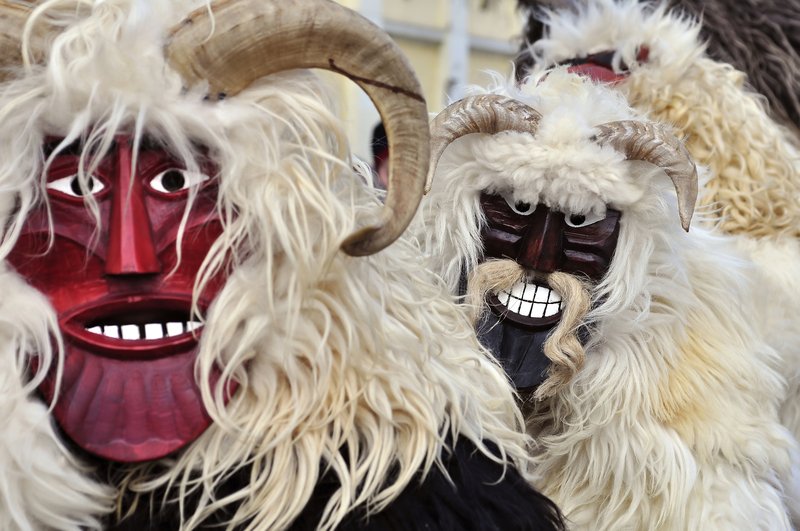Traditional Busó Festival in Mohács - Updated with the 2025 program dates
Image credit: Jakatics - Dreamstime.com
Carnival time means it’s Busó time in Southern Hungary. The traditional end-of-winter Busó Festival (Busójárás) in Mohács is one of the top tourist attractions in Hungary, with thousands of visitors every year. Busójárás has its roots in the traditions of the Šokci ethnic group and is inscribed on the UNESCO World Heritage list.
Find the program of the 2025 Busó Festival at the end of this article.
Traditional end-of-winter celebration in Southern Hungary
The Busó Carnival, held every year in late February in Mohács, is a six-day celebration to mark the end of winter. The frightening-looking Busós are costumed people (traditionally men) wearing wooden masks and big woolly cloaks. Their main task is to scare the winter away.
During the festival, there are different programs, singing, folk dance performances, and a display of traditional mask carvers and other craftspeople. The main attraction is the arrival of Busós by rowboats on the Danube and their march through the city with traditional horse-drawn or motorized fantasy vehicles. The festival ends with the burning of a coffin - symbolizing winter - on a bonfire.
Image credit: Joruba - Dreamstime.com
Busó Festival in Mohács
The time of the Busó Carnival in Mohács is determined by the first full moon after the spring solstice.
Festivities start on a Thursday, followed by the Little Carnival (Kisfarsang) on Friday.
The biggest celebration is the Carnival Sunday (Farsang vasárnap) on the seventh Sunday before Easter Sunday.
The whole event ends with the Burial of the Carnival (Farsangtemetés) on the following Tuesday (Shrove Tuesday or Mardi Gras).
For a summary of this year's program, scroll to the end of this article.
Credit: Aperti Film / YouTube
Legend and history of Busójárás
According to the most popular legend, during the Ottoman (Turkish) invasion, the people of Mohács fled the town and started living in the nearby swamps. Fed up with the oppression, on a stormy night the Šokci men living in the swamps invaded the city. They marched in, dressed in costumes and frightening masks, carrying primitive handmade weapons and making as much noise as they could create.
The story goes that the Turks were so frightened by the noise, the masks, and the storm, that they thought demons were attacking them and ran away from the town before sunrise.
However exciting and popular, historical data shows that it is just a legend. The city was liberated from Ottoman rule in 1687 and the large-scale settlement of Šokci people started only about ten years later.
Probably the Šokci brought the custom with themselves to Mohács which then developed into its present form during the centuries. Of course, modern-day Busójárás has a lot more touristy side than back in the days, but the main elements of the celebration were preserved during the centuries.
Image credit: Skovalsky - Dreamstime.com
2025 program dates of the Busó Festival in Mohács
The event has a large number of programs and is held at different locations.
The 2025 Busó Carnival in Mohács starts on Thursday, February 27, with an opening parade at 14:45 on the Táncsics Street - Szabadság Street - Széchenyi Square route. Amongst others, children’s folk dance group and Busó group performances will be on this afternoon’s program. The last program of the day starts at 19:00.
On Friday, February 28, programs start at 10:30 a.m. and include an exhibition of a drawing competition, the introduction of folk dance groups and bands at two different locations, and the opening of an exhibition with works by mask makers and other folk art creators.
Friday’s last program, South Slavic dance, will start at 19:00.
Programs on Saturday, March 1, start at 9:00 at the Kanizsai Dorottya Museum. Tambura bands, folk dance ensembles, and busó groups will perform throughout the day. Saturday’s program also includes a folk arts and crafts fair, carnival preparations, folk dance, and gastronomy presentations. The Botos busó group's wedding parade via Busóudvar - Kompkikötő - Selyemgyár - Széchenyi Square - Bensheim Square starts at 14:00. Between 14:00 and 18:00 mask carving demonstration, carnival play, carriage decoration, cooking of Šokci beans, and food tasting will be on the program in Síp street.
Credit: Visit Hungary / YouTube
The highlight of the event, Carnival Sunday, on March 2, hosts the most well-known programs, starting at 9:00. The famous arrival of the Busós on rowboats at Sokacrév will start right after midday, while the carnival parade starts from Kóló Square at 14:00, and follows the Kóló Square - Tomori Street - Dózsa György Street - Szabadság Street - Széchényi Square route. The carnival coffin will be put to water at the Mohács ferry port at 16:30. A huge bonfire, dancing, and singing will close this day.
Busós will pay their traditional visit to houses on Kóló Square and in nearby streets on Monday, March 3.
Burial of the Carnival will be on Shrove Tuesday, March 4, with another carnival parade starting at 14:30, followed by folk dance and music programs in the afternoon. The highlight of the day is the burning of the coffin, symbolizing winter, on a bonfire, from 18:00.
Note: organizers reserve the right to change the program without previous notice.
Program source: mohacsibusojaras.hu


